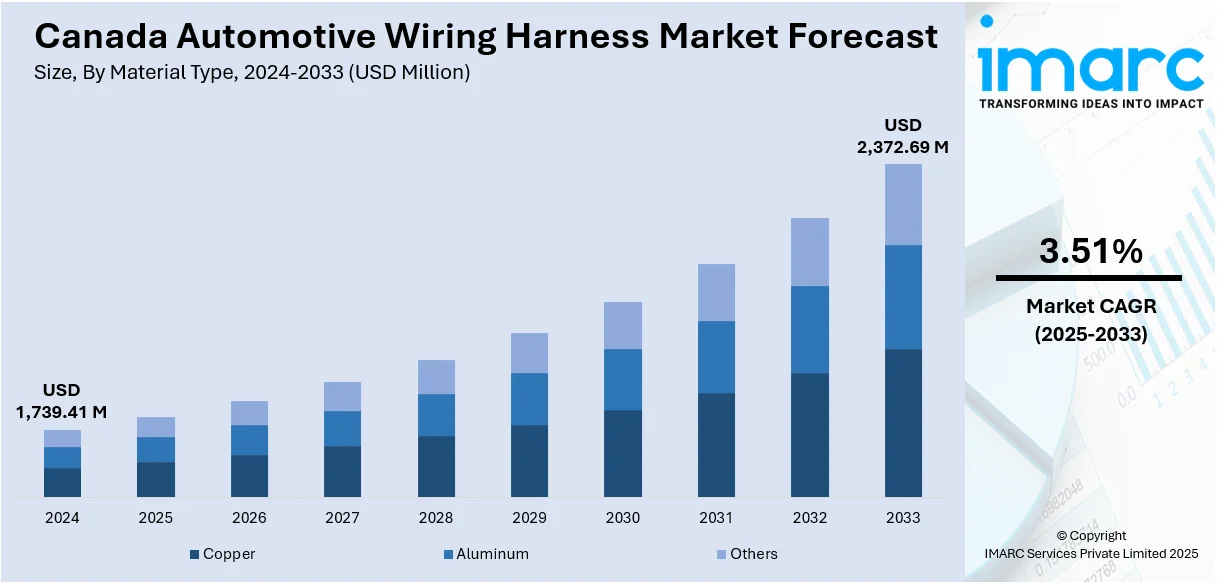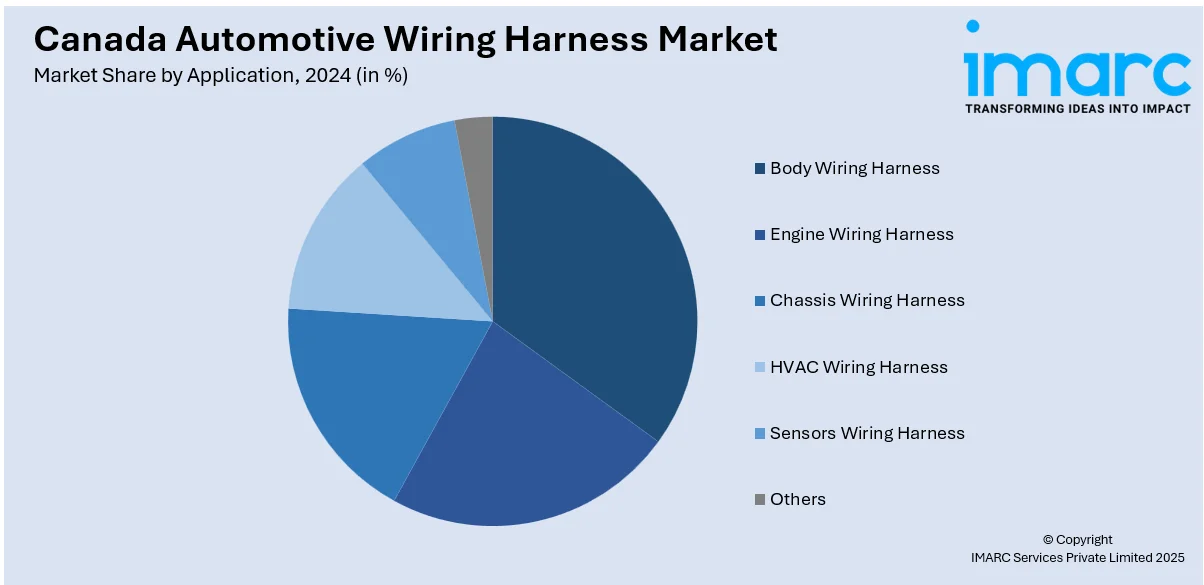
Canada Automotive Wiring Harness Market Size, Share, Trends and Forecast by Application, Material Type, Transmission Type, Vehicle Type, Category, Component, and Region, 2025-2033
Canada Automotive Wiring Harness Market Overview:
The Canada automotive wiring harness market size reached USD 1,739.41 Million in 2024. Looking forward, the market is expected to reach USD 2,372.69 Million by 2033, exhibiting a growth rate (CAGR) of 3.51% during 2025-2033. The market is driven by a surge in electric vehicle production, growing adoption of ADAS, and rising local vehicle assembly. Cold-weather performance and thermal management are critical product attributes. Increasing automation also shapes production strategy, furthering Canada automotive wiring harness market share.
|
Report Attribute
|
Key Statistics
|
|---|---|
|
Base Year
|
2024
|
|
Forecast Years
|
2025-2033
|
|
Historical Years
|
2019-2024
|
| Market Size in 2024 | USD 1,739.41 Million |
| Market Forecast in 2033 | USD 2,372.69 Million |
| Market Growth Rate 2025-2033 | 3.51% |
Canada Automotive Wiring Harness Market Trends:
Electrification and Climate-Adapted Harness Solutions
From January to April 2024, battery electric vehicle (BEV) registrations in Canada rose 57% year-over-year, while plug-in hybrid (PHEV) registrations jumped 75%. Quebec led with 50.6% of national BEV registrations, followed by British Columbia (20.6%) and Ontario (22.5%). Canada’s national BEV market share reached 8.5% during this period. Canada’s rapidly expanding EV sector demands high-voltage harness systems with robust insulation and thermal properties to endure sub-zero temperatures. High-current battery connectors, motor busbars, and thermal monitoring cables must comply with extreme-weather standards. Suppliers are developing UV- and salt-resistant jackets, heated loom options, and sealed terminal housings. These harnesses enable safe and efficient power transmission for EVs in northern climates. Local testing facilities simulate freeze/thaw cycles to ensure product durability and regulatory compliance. As OEMs localize EV production, sourcing proximity improves agility. This trend positions Canada as a technically advanced supplier base for climate-resilient components, directly advancing Canada automotive wiring harness market growth.

To get more information on this market, Request Sample
ADAS and Infotainment Expansion
As vehicle technology adoption rises, Canadian manufacturers are integrating increasingly sophisticated driver-assistance and entertainment systems. For instance, as per industry reports, in 2024, 84% of new vehicles sold in Canada were equipped with ADAS features. Harnesses for these applications include high-speed data lines, multi-function connectors, and redundancy circuits for fail-safe operation. Infotainment and sensor wiring are routed in increasingly compact chassis architectures, requiring advanced design software and routing simulations. Suppliers emphasize EMI protection and signal stability through shielded configurations and precise grounding. The shift toward semi-autonomous functionality in mainstream vehicles is expanding the complexity and value of wiring looms. This product evolution demands skilled labor and advanced manufacturing tools, both of which are being developed locally. Such demand directly boosts Canada automotive wiring harness market growth.
Canada Automotive Wiring Harness Market Segmentation:
IMARC Group provides an analysis of the key trends in each segment of the market, along with forecasts at the country/regional level for 2025-2033. Our report has categorized the market based on application, material type, transmission type, vehicle type, category, and component.
Application Insights:

- Body Wiring Harness
- Engine Wiring Harness
- Chassis Wiring Harness
- HVAC Wiring Harness
- Sensors Wiring Harness
- Others
The report has provided a detailed breakup and analysis of the market based on the application. This includes body wiring harness, engine wiring harness, chassis wiring harness, HVAC wiring harness, sensors wiring harness, and others.
Material Type Insights:
- Copper
- Aluminum
- Others
A detailed breakup and analysis of the market based on the material type have also been provided in the report. This includes copper, aluminum, and others.
Transmission Type Insights:
- Data Transmission
- Electrical Wiring
The report has provided a detailed breakup and analysis of the market based on the transmission type. This includes data transmission and electrical wiring.
Vehicle Type Insights:
- Two Wheelers
- Passenger Cars
- Commercial Vehicles
A detailed breakup and analysis of the market based on the vehicle type has also been provided in the report. This includes two wheelers, passenger cars, and commercial vehicles.
Category Insights:
- General Wires
- Heat Resistant Wires
- Shielded Wires
- Tubed Wires
The report has provided a detailed breakup and analysis of the market based on the category. This includes general wires, heat resistant wires, shielded wires, and tubed wires.
Component Insights:
- Connectors
- Wires
- Terminals
- Others
A detailed breakup and analysis of the market based on the component have also been provided in the report. This includes connectors, wires, terminals, and others.
Regional Insights:
- Ontario
- Quebec
- Alberta
- British Columbia
- Others
The report has also provided a comprehensive analysis of all the major regional markets, which include Ontario, Quebec, Alberta, British Columbia, and others.
Competitive Landscape:
The market research report has also provided a comprehensive analysis of the competitive landscape. Competitive analysis such as market structure, key player positioning, top winning strategies, competitive dashboard, and company evaluation quadrant has been covered in the report. Also, detailed profiles of all major companies have been provided.
Canada Automotive Wiring Harness Market News:
- In February 2025, Lear Corporation acquired StoneShield Engineering, a Portugal-based automation specialist focused on the wire harness industry. StoneShield brings expertise in robotics, automated taping, and high-voltage harness assembly. The acquisition strengthens Lear’s E-Systems business and supports its IDEA strategy to advance manufacturing through digital and automated technologies.
- In May 2024, Yazaki and Toray Industries developed a recycled polybutylene terephthalate (PBT) resin grade for automotive wiring harness connectors. This resin, made from manufacturing scrap, lowers carbon emissions while matching the performance of virgin materials. The collaboration aims to support a carbon-neutral, circular economy in the automotive industry.
Canada Automotive Wiring Harness Market Report Coverage:
| Report Features | Details |
|---|---|
| Base Year of the Analysis | 2024 |
| Historical Period | 2019-2024 |
| Forecast Period | 2025-2033 |
| Units | Million USD |
| Scope of the Report |
Exploration of Historical Trends and Market Outlook, Industry Catalysts and Challenges, Segment-Wise Historical and Future Market Assessment:
|
| Applications Covered | Body Wiring Harness, Engine Wiring Harness, Chassis Wiring Harness, HVAC Wiring Harness, Sensors Wiring Harness, Others |
| Material Types Covered | Copper, Aluminum, Others |
| Transmission Types Covered | Data Transmission, Electrical Wiring |
| Vehicle Types Covered | Two Wheelers, Passenger Cars, Commercial Vehicles |
| Categories Covered | General Wires, Heat Resistant Wires, Shielded Wires, Tubed Wires |
| Components Covered | Connectors, Wires, Terminals, Others |
| Regions Covered | Ontario, Quebec, Alberta, British Columbia, Others |
| Customization Scope | 10% Free Customization |
| Post-Sale Analyst Support | 10-12 Weeks |
| Delivery Format | PDF and Excel through Email (We can also provide the editable version of the report in PPT/Word format on special request) |
Key Questions Answered in This Report:
- How has the Canada automotive wiring harness market performed so far and how will it perform in the coming years?
- What is the breakup of the Canada automotive wiring harness market on the basis of application?
- What is the breakup of the Canada automotive wiring harness market on the basis of material type?
- What is the breakup of the Canada automotive wiring harness market on the basis of transmission type?
- What is the breakup of the Canada automotive wiring harness market on the basis of vehicle type?
- What is the breakup of the Canada automotive wiring harness market on the basis of category?
- What is the breakup of the Canada automotive wiring harness market on the basis of component?
- What is the breakup of the Canada automotive wiring harness market on the basis of region?
- What are the various stages in the value chain of the Canada automotive wiring harness market?
- What are the key driving factors and challenges in the Canada automotive wiring harness market?
- What is the structure of the Canada automotive wiring harness market and who are the key players?
- What is the degree of competition in the Canada automotive wiring harness market?
Key Benefits for Stakeholders:
- IMARC’s industry report offers a comprehensive quantitative analysis of various market segments, historical and current market trends, market forecasts, and dynamics of the Canada automotive wiring harness market from 2019-2033.
- The research report provides the latest information on the market drivers, challenges, and opportunities in the Canada automotive wiring harness market.
- Porter's five forces analysis assist stakeholders in assessing the impact of new entrants, competitive rivalry, supplier power, buyer power, and the threat of substitution. It helps stakeholders to analyze the level of competition within the Canada automotive wiring harness industry and its attractiveness.
- Competitive landscape allows stakeholders to understand their competitive environment and provides an insight into the current positions of key players in the market.
Need more help?
- Speak to our experienced analysts for insights on the current market scenarios.
- Include additional segments and countries to customize the report as per your requirement.
- Gain an unparalleled competitive advantage in your domain by understanding how to utilize the report and positively impacting your operations and revenue.
- For further assistance, please connect with our analysts.
 Request Customization
Request Customization
 Speak to an Analyst
Speak to an Analyst
 Request Brochure
Request Brochure
 Inquire Before Buying
Inquire Before Buying




.webp)




.webp)












